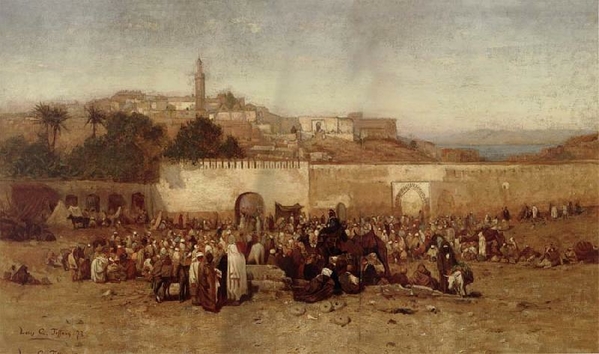A few weeks ago, I visited the Queens Museum in New York City for several exhibits, not one of which was the one I was most impressed by: a selection of work from the Neustadt Collection of Tiffany Glass.
Tiffany is a true glamour name, whether you're thinking of the jewelry store or Tiffany lamps and glass. In many people's minds, glamour means Manhattan. But this story is about one of New York's other boroughs, home to the Queens Museum, to an orthodontist and his wife who fell in love with an out-of-fashion lamp, and to the workshops and factories built by Louis Comfort Tiffany.

What Tiffany did before glass (Market Day, 1873)
Tiffany—yes, he was the son of the jeweler, and at points in his life design director of the store—started out as a landscape painter, a student of George Inness. After a few years, he developed an interest in glasswork, studied at several Brooklyn glassworks, and set off on the path we all know about.
He set up a glass company in Queens, just over a mile and a half from the museum, and expanded it over time until it covered two blocks of glass-making furnaces, design workshops and assembly spaces for lamps, windows, walls, and many kinds of metal decorative objects.
The lamp business, probably the best-known of Tiffany's work, was a product of the time: late in the so-called 'Gilded Age' electric lighting was invented; without it, glass lamps like that would have quickly become soiled by smoke from oil or gas lighting.
But electricity was not the only change in glass artistry of that time; Tiffany and others, including John LaFarge, began using carefully selected pieces of colored glass edge-wrapped with copper and soldered together to create artworks; for hundreds of years before, stained-glass windows were primarily colors painted on semi-colorless grisaille glass.
Part of the reason Tiffany began to make his own glass was progress in making pure cheap glass for bottles and other uses; Tiffany wanted impurities in the glass to catch light in different ways and create variations within a piece of glass. It's one of those ironies, like the story of salt: For centuries, the goal was pure white salt—but now that it's ubiquitous and cheap, people pay extra for gourmet impure salts of all kinds.
For decades, Tiffany Studios thrived, producing handmade but standard pieces as well as commissions for wealthy families, churches and public buildings. The White House got Tiffany panels, the wealthiest churches ordered Tiffany windows, and the middle class could find a reasonable table lamp. But tastes change, and by the 1920s the company was shrinking; in the 1930s it closed, and its products were considered 'old-fashioned' and unwanted.
But not by everyone. Egon and Hildegard Neustadt, immigrants from Austria married in 1935, and went looking for used furniture for their Queens apartment. In one second-hand store they found and fell in love with a Tiffany Daffodil shade that Hildegard said gave "a fascinating effect of real flowers growing in a real garden." But their budget was tight, and they waited until a second visit when they were able to buy it for $12.50. That's it, just above.
As Egon straightened more and more teeth and dabbled in real estate, the couple were able to continue buying; by the time Dr Neustadt died in 1984, the collection had become the largest private collection anywhere. The Neustadt Collection keeps rotating selections in the Queens Museum gallery, and also has traveling (and lately, virtual traveling) exhibitions elsewhere.
Some more Tiffany pieces; the one at bottom is a tea tray.
One of the most unusual parts of the Neustadt collection was added in 1957 when the Neustadts bought the entire remaining inventory of Tiffany's colored flat and pressed glass, the raw material from which skilled craftspeople would select just the right piece to fit the pattern and cut it. As our One-Clue Mystery, a portion of the inventory was recognized by Professor Abe and George G.
Along with the Neustadt Collection exhibition, the museum has an exhibit showing the process of making some of the glass pieces, from making a wooden model to show the shapes and sizes of pieces, to finding just the right piece of glass, and more.
And this may be the point to remind that at its peak there were 300 people working in the Tiffany complex; some made glass, some selected glass pieces and fitted them together following design patterns, and some—the so-called 'Tiffany Girls'—were actually responsible for many of the lamp designs and other pieces. Tiffany himself worked on large projects, made sketches, approved designs, and didn't give public credit to the other designers.
Desktop furnace to keep soldering irons hot
What he did do, was maintain an interest in glass technology, searching for new effects, new ways to reflect and absorb light. Tiffany's lab employed chemists finding formulas to produce colors and effects. The goal was to combine the luster that came from adding silver nitrate in the melted glass and then adding metallic salts to the cooling surface. The vases below are examples.
The page below, overlaid with museum narrative and tinted for effect, is from the lab books of Tiffany's chemists, with notes for chemicals and proportions to be used in the glass factory. It was clearly still a competitive business: Note the line that says "Don't let anyone see you mix the above."
The Queens Museum is in Flushing Meadow Park, scene of the 1939 and 1964 World's Fairs and has a variety of artistic and historic exhibits, including one on New York's water system. It's open 12-5 Wednesday to Friday and 11-5 on weekends. Admission is free, but during Covid online timed tickets are needed; they're available at queensmuseum.org/visit


Comments (0)